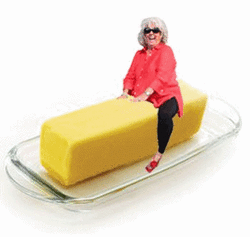 "With enough butter, anything is good." - Julia Child I thoroughly enjoy butter. Sauteing a mirepoix, on toast with ikrá (roe), cooking eggs, in baked goods….salty, sweet with its creamy mouth feel…delightful. But it has such a bad rap, doesn't it? The purpose of my blog article today is an attempt to redeem butter. Cardiovascular disease is the leading cause of death in the United States, claiming 631,636 lives in 2006 and accounting for more than 1 in 4 (26%) of all deaths that year. Risk factors for cardiovascular disease include high blood cholesterol, hypertension, diabetes, obesity/overweight, and poor diet. The role of butter -- and other high-fat dairy products -- in raising cholesterol levels is debated among scientists. Many mainstream nutrition authorities conclude that butter is bad for cholesterol levels. However, a recent review in the Advances in Nutrition journal conclude that though butter increases LDL (low-density lipoprotein aka “lousy”) cholesterol, it also increases HDL (high-density lipoprotein aka “healthy”) cholesterol and therefore might not affect or can even lower our total cholesterol ratio. Other research confirms that there is no significant evidence concluding that dietary saturated fat is associated with an increased risk of cardiovascular disease. Additional research even suggests bioactive properties of dairy fat and their role in reduced adiposity. Though daunting to read, Good Calories, Bad Calories by Gary Taubes is a great resource that addresses this low-fat conundrum and details the compelling case that refined carbohydrates are in fact the primary cause of weight gain and “diseases of civilization” such as heart disease, hypertension and diabetes. More about that in a later post. The jury may still be out, but I do not fear butter. However, before you start cooking Paula Deen style do understand that butter and high-fat dairy products are high in calories, which we all need to be mindful of for successful weight maintenance. One last note: not all butter is created equal. Mike’s Daily Apple did a great review of grass-fed vs. grain-fed butter regarding its health composition and taste. Grass-fed was the winner with a higher vitamin content, better fatty acid composition and better taste. Kerrygold is an example of grass-fed butter you can purchase at most grocery stores, in addition to Organic Valley Pasture Butter. Finally, it is also important to keep in mind that many toxins are stored in animal fat. According to the FDA, most human exposure to dioxins comes from food, with 95 percent of that coming from animal fats. Ahh…though I do love butter so, there is still a call to my favorite mantra about moderation. Enjoy your butter, buy good quality butter, but use it judiciously.
1 Comment
|
AuthorHello and welcome! My name is Andrea Notch Mayzeles. I am a Certified Health Education Specialist, Mom, and Master of Public Health dedicated to the path of well-being. As a wellness professional I am committed to continued learning and am here to share research, recipes and musings on health, psychology, personal development, and parenting. I hope you enjoy! Categories
All
|

 RSS Feed
RSS Feed